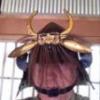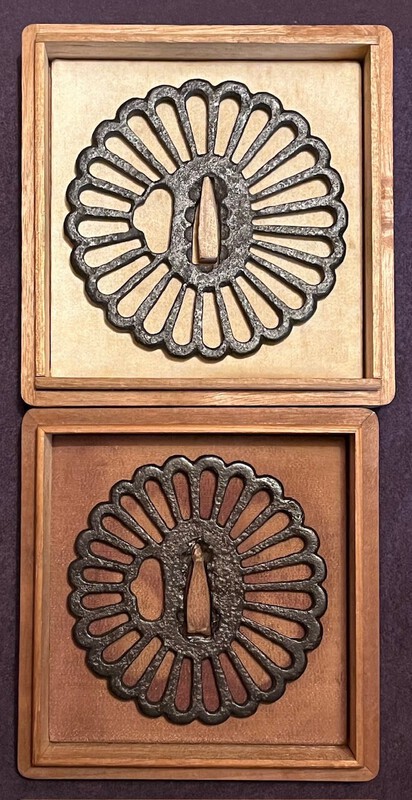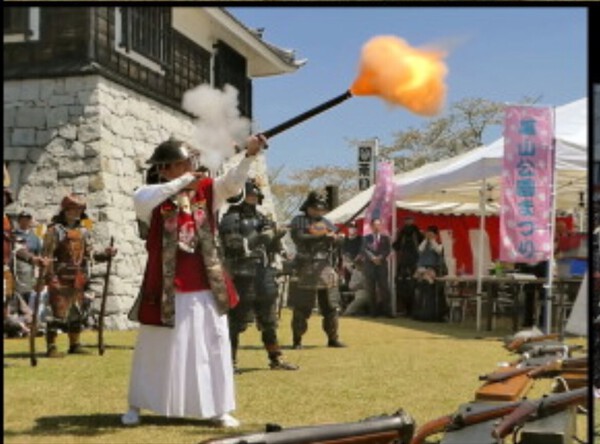-
Posts
12,563 -
Joined
-
Last visited
-
Days Won
201
Content Type
Profiles
Forums
Events
Store
Downloads
Gallery
Everything posted by Bugyotsuji
-
Thanks for the comments, Alex, helping to advance the game. The larger one seems to be closer to a perfect ‘maru-gata’ circle. The Tagane hits around the seppa dai are different too. Possibly an owner kept both as alternatives for a particular tachi…(?)
-
I’m biased, coz I like green!
-
Ah, signed by Nagata, so it must be NKBKHK certificate, which may be the best there is. And ‘tokubetsu kitchō’ means especially valuable (historically, culturally). Why do you ask?
-
Sold as Dai/Sho, both are iron and fairly large, both have 24 petals (菊花 Kik-ka) and both have a kōgai-ana on omoté left, suggesting use for tachi. (?) Dai: 9.3 x 9.3 x 0.5 Sho: 8.8 x 8.55 x 0.45 My guess is Muromachi~Momoyama. So how could they be Dai-sho? Should I really be keeping them together? Why are these unsigned chrysanthemum tsuba called Saotomé? Etc., etc.
-

" One of the World's Oldest Samurai Swords Was Found in an Attic "
Bugyotsuji replied to Franco D's topic in Nihonto
Just trying to be the interpreter here, but not working so I’m out. -
There is no certifying body shown in the photo, Yves. And how far do you want the translation, e.g. all the words into English?
-

" One of the World's Oldest Samurai Swords Was Found in an Attic "
Bugyotsuji replied to Franco D's topic in Nihonto
Well I read your comment the same way as Franco, that you were questioning its legitimacy, as if you knew something or had heard something. That’s why he asked what you were getting at, what your comment was supposed to mean. -
Not getting much thanks for answering you, Yves, but here goes just once more. You have not included the name of the organization in your photo, so we are left to guess.
-

" One of the World's Oldest Samurai Swords Was Found in an Attic "
Bugyotsuji replied to Franco D's topic in Nihonto
So Jim, you suggest it could be a fake? -
“Edo Jidai, Zenki” means the first part of the Edo Period. (First 1/3rd) Maybe 1600s. Actually I think that description is quite full. *If it had said “Edo Shoki” then that would have been the very beginning of Edo.
-

Edo Period Corner Part II
Bugyotsuji replied to estcrh's topic in General Nihonto Related Discussion
Fuzzy, but an interesting shot of 礼射 ‘Reisha’ at our third event this year, up at Susai Castle on 14 April 2024. -

" One of the World's Oldest Samurai Swords Was Found in an Attic "
Bugyotsuji replied to Franco D's topic in Nihonto
It was my fault, the way I phrased it. I should be asking for forgiveness. Thank you for your always scholarly input! -

" One of the World's Oldest Samurai Swords Was Found in an Attic "
Bugyotsuji replied to Franco D's topic in Nihonto
Yes Franco, we all know it means 'old Hoki' from the Tottori/Japan Sea side of Japan, but surely ordinary readers would not, especially without the Kanji. -

" One of the World's Oldest Samurai Swords Was Found in an Attic "
Bugyotsuji replied to Franco D's topic in Nihonto
Not really a reader-friendly article either. It doesn't explain for example what 'kohoki' is supposed to mean. Here is a more detailed article in Japanese. 最古級の日本刀、なぜ天井裏に?春日大社、80年前発見 (higashiyamatoarchive.net) Even so this is another reason to take that trip pilrimage to Kasuga Taisha and Nara Park. -
Certificate Edo Jidai, Zenki, Tokubetsu Kitchō. Tetsu Kuro Urushi Nuri Kitsuké Kozané Moegi ito odoshi Ni-mai Dō Gusoku
-
Ah, thanks for that. I see what you mean! These Kozuka blade Mei were mostly (but not always) a dedication in admiration to a famous swordsmith, so they would be unlikely to tell you anything about whoever made the little blade itself. (Signatures you find on the Kozuka ‘fukuro’ however usually do indicate the artisan, though you need to watch out for fakes!)
-
CC, the word Kozuka means ‘small handle’. A useful blade is inserted into this handle, so the two together are also referred to as ‘Kozuka’. In your case I am asking where the Mei is, on the steel blade or on the main work of art, the Kozuka handle, sometimes referred to as the fukuro or ‘bag’.
-
As to David's interesting example, rather than an obvious cross, I see rounded stained glass windows, Roman Catholic.
-
Rather large Namban here, 8.7 x 8.2 cm., with dragons and flower bases ('capsules'?) set with 7 (4+3) small amber cabochons. Silver fukurin. Attractive but I wonder what the story behind this might be…(?)
-
The fittings have a kind of Mino feel to them. Nice package so far. The kozuka with kumade and mi design looks good from here. When you say a worn 'signature' do you refer to the kozuka blade, or to the handle metalwork?
-
Definitely not 刀 katana, in which the strokes never cross. The kanji 力 chikara/ryoku/riki with the meaning of power, strength, surge, grit, etc. (As opposed to カ ka in katakana, which has no intrinsic meaning except to designate pronunciation, or to question something, and か ka in hiragana with an extra stroke, again to represent a sound.)
-
How could I have missed this thread? Dang.
-

Edo Period Corner Part II
Bugyotsuji replied to estcrh's topic in General Nihonto Related Discussion
Turn up the volume! April 7, 2024 on the bridge at Shinjo Village, where the famous Sakura de Triomphe (Gaisen Sakura) are located. Three ladies start us off with a 'Reisha' or salute. At 14:30 I get knocked off my feet by the 50 Monme hand cannon. The 100 Monme (19:50) towards the end is good! -

Edo Period Corner Part II
Bugyotsuji replied to estcrh's topic in General Nihonto Related Discussion
He specialized in the Bakumatsu. As you slid open the front door for the very first time, this is what guests saw in front of them: -

Edo Period Corner Part II
Bugyotsuji replied to estcrh's topic in General Nihonto Related Discussion










